Using High-Resolution Satellites To Measure African Farm Yields
Stanford researchers have developed a new way to estimate crop yields from space, using high-res photos snapped by a new wave of compact satellites.
The approach, detailed in the February 13 issue of the journal of the Proceedings of the National Academy of Sciences, could be used to estimate agricultural productivity and test intervention strategies in poor regions of the world where data are currently extremely scarce.
“Improving agricultural productivity is going to be one of the main ways to reduce hunger and improve livelihoods in poor parts of the world,” said study-coauthor Marshall Burke, an assistant professor in the department of Earth System Science at Stanford’s School of Earth, Energy & Environmental Sciences. “But to improve agricultural productivity, we first have to measure it, and unfortunately this isn’t done on most farms around the world.”
Earth-observing satellites have been around for over three decades, but most of the imagery they capture has not been high-enough resolution to visualize the very small agricultural fields typical in developing countries. Recently, however, satellites have shrunk in both size and cost while simultaneously improving in resolution, and today there are several companies competing to launch refrigerator- and shoebox-sized satellites into space that take high resolution images of the earth.
“You can get lots of them up there, all capturing very small parts of the land surface at very high resolution,” said study-coauthor David Lobell, an associate professor in the Department of Earth System Science. “Any one satellite doesn’t give you very much information, but the constellation of them actually means that you’re covering most of the world at very high resolution and at very low cost. That’s something we never really had even a few years ago.”
In the new study, Burke and Lobell set out to test whether the images from this new wave of satellites are good enough reliably estimate crop yields. The pair focused on an area in Western Kenya where there are a lot of smallholder farmers that grow maize, or corn, on small, half-acre or one-acre lots. “This was an area where there was already a lot of existing field work,” Lobell said. “It was an ideal site to test our approach.”
The scientists compared two different methods for estimating agricultural productivity yields using satellite imagery. The first approach involved “ground truthing,” or conducting ground surveys to check the accuracy of yield estimates calculated using the satellite data, which was donated by the company Terra Bella. For this part of the study, Burke and his field team spent weeks conducting house-to-house surveys with his staff, talking to farmers and gathering information about individual farms.
“We get a lot of great data, but it’s incredibly time consuming and fairly expensive, meaning we can only survey at most a thousand or so farmers during one campaign,” Burke said. “If you want to scale up our operation, you don’t want to have to recollect ground survey data everywhere in the world.”
For this reason, the team also tested an alternative “uncalibrated” approach that did not depend on ground survey data to make predictions. Instead, it uses a computer model of how crops grow, along with information on local weather conditions, to help interpret the satellite imagery and predict yields.
“Just combining the imagery with computer-based crop models allows us to make surprisingly accurate predictions, just based on the imagery alone, of actual productivity on the field,” Burke said.
The researchers have plans to scale up their project and test their approach across more of Africa. “Our aspiration is to make accurate seasonal predictions of agricultural productivity for every corner of Sub-Saharan Africa,” Burke said. “Our hope is that this approach we’ve developed using satellites could allow a huge leap in in our ability to understand and improve agricultural productivity in poor parts of the world.”
Lobell is also the deputy director of Stanford’s the Center on Food Security and the Environment and a Senior Fellow at the Stanford Woods Institute for the Environment.

